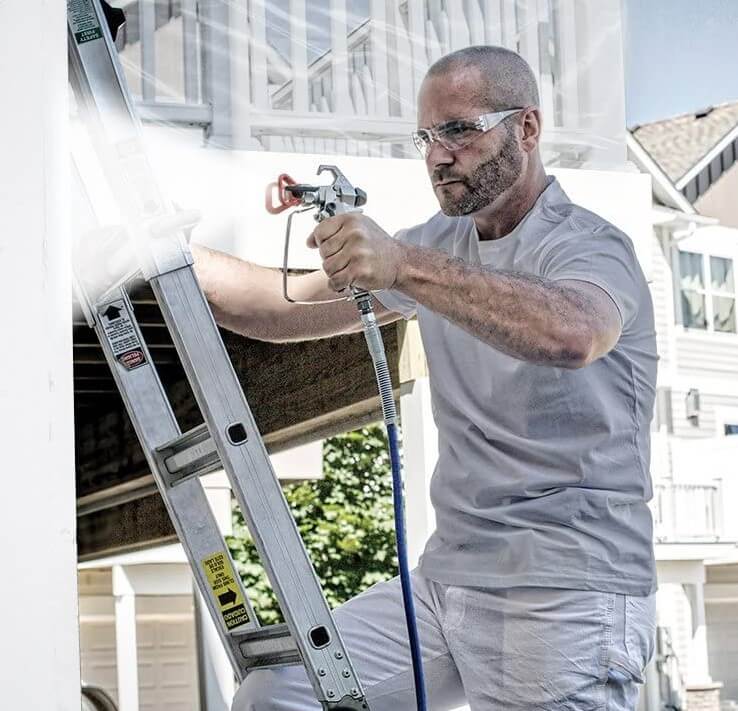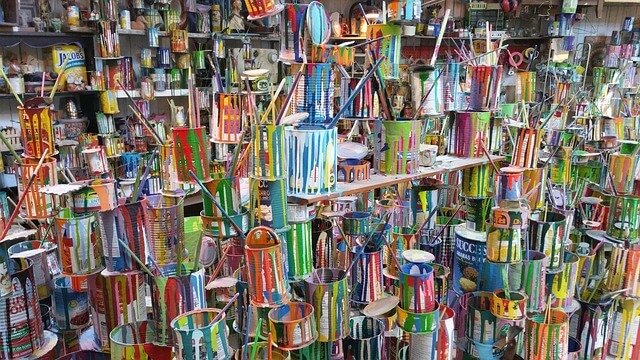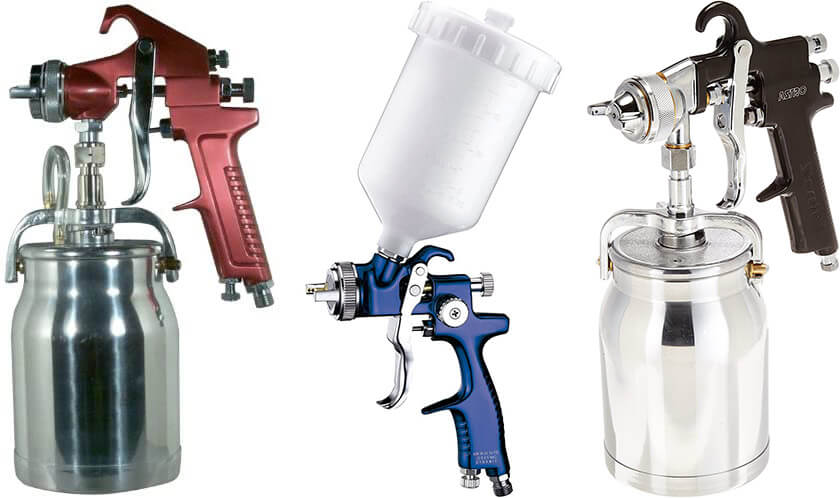What are the different types of paint sprayers?
 There are five main variants of paint sprayers for conventional use and two for industrial use. Airless and air-assisted are used for conventional use as well as large-scale use.
There are five main variants of paint sprayers for conventional use and two for industrial use. Airless and air-assisted are used for conventional use as well as large-scale use.
- Compressed air paint sprayer
- Airless Paint Sprayers
- Air-assisted airless sprayers
- HVLP (High Volume Low Pressure) paint sprayers
- LVLP (Low Volume Low Pressure) paint sprayers
- Electrostatic paint sprayer
- Rotary bell paint sprayers
Let’s discuss each of the different types more before you decide which type suits your need.
Table of Contents
- What type of paint sprayer do I need?
- (1) Compressed air sprayers
- (2) Airless sprayers
- (3) Air-assisted airless sprayers
- (4) HVLP (High Volume Low Pressure) sprayers
- (5) LVLP (Low Volume Low Pressure) sprayers
- (6) Electrostatic sprayer
- (7) Rotary bell sprayers
- What type of sprayer is best for small projects?
- What type of sprayer is best for medium projects?
- What type of sprayer is best for large projects?
- Conclusion
- Frequently Asked Questions
What type of paint sprayer do I need?
Choosing the right paint sprayer depends on several factors, including time, budget, project size, the type of material used, and the desired finish. Here are some general guidelines to consider when selecting a paint sprayer:
Project size:
For small to medium projects, such as painting furniture or cabinets, HVLP or LVLP sprayers may be a good choice. A handheld cordless sprayer may be enough. For larger projects, such as painting walls or exterior surfaces, airless or air-assisted airless sprayers may be a better option.
Material type:
Airless sprayers are better suited for heavier materials, such as enamels and thick paints, while HVLP or LVLP sprayers are better suited for thinner materials, such as stains and lacquers.

Finish quality:
If a high-quality finish is desired, HVLP or LVLP sprayers are typically the best options, as they produce a finer spray pattern and less overspray. Rotary bell sprayers may be the best option for textured or heavy-bodied paints.
Budget:
Some paint sprayers, such as airless and electrostatic sprayers, can be more expensive than others. Consider your budget and how frequently you will use the sprayer before purchasing.
Experience level:
Some paint sprayers, such as compressed air sprayers, may require more skill and experience to operate effectively. If you are new to using paint sprayers, consider a simpler option, such as an HVLP or LVLP sprayer.
Ultimately, the choice of paint sprayer will depend on your specific needs and preferences. It can be helpful to research different models and read reviews from other users to help inform your decision.
Here’s a table comparing compressed air vs airless vs Air-assisted vs HVLP vs LVLP paint sprayers based on various factors:
| Compressed air | Airless | Air-assisted airless | HVLP | LVLP | |
|---|---|---|---|---|---|
| Paint types | Compatible with most paints | Compatible with most paints | Compatible with most paints | Best for thin to medium viscosity paints | Best for thin to medium viscosity paints |
| Pump type | Pneumatic | Hydraulic | Hydraulic | Turbine or compressor | Diaphragm or piston |
| Pressure | Typically up to 60 PSI | Can handle high pressures up to 3,000 PSI | Can handle high pressures up to 3,000 PSI | Low pressure, typically 7-14 PSI | Low pressure, typically 4-10 PSI |
| Air Volume | High air volume | No air required | Low air volume | Low air volume | Low air volume |
| Atomization | Coarse to fine atomization | Fine atomization | Fine atomization | Very fine atomization | Very fine atomization |
| Cost-effectiveness | Affordable | More expensive than compressed air sprayers but faster and more efficient | More expensive than compressed air sprayers but faster and more efficient | More expensive than compressed air sprayers but more efficient with less overspray | More expensive than compressed air sprayers but more efficient with less overspray |
| Time spent | Can be time-consuming due to frequent refills and cleanups | Fast and efficient for large projects | Fast and efficient for large projects | Fast and efficient for small to medium projects | Fast and efficient for small to medium projects |
| Transfer efficiency | Typically lower transfer efficiency due to overspray | High transfer efficiency due to no overspray | High transfer efficiency due to less overspray | High transfer efficiency due to limited overspray | High transfer efficiency due to limited overspray |
(1) Compressed air sprayers
Compressed air sprayers use compressed air to atomize paint and provide greater control over the spray pattern. They are suitable for fine finishes and precision work.
The sprayer has several advantages over other types of paint sprayers, including:
- Fine control: Compressed air sprayers offer greater control over the amount of paint applied, making them ideal for detailed work and touch-ups.
- Wide range of materials: Compressed air sprayers can handle a wide range of materials, from thin stains and lacquers to heavy-bodied paints and enamels.
- Consistent finish quality: Compressed air sprayers produce a consistent finish quality, with no streaks or uneven spots.
- Easy to clean: Compressed air sprayers are easy to clean and maintain, making them a good choice for frequent use.
However, compressed air sprayers are known for producing a lot of oversprays, which can result in significant waste and mess. They can also be more time-consuming to set up and operate than other sprayers, and they require a source of compressed air (air compressor) to function.
(2) Airless sprayers
Airless sprayers use high pressure to atomize paint into fine particles. They are suitable for large projects and heavy materials.
These sprayers have several advantages over other types of paint sprayers, including:
- Faster application: Airless paint sprayers can cover large areas quickly and efficiently, making them a good choice for large projects.
- Suitable for thicker materials: Airless sprayers can handle thicker materials, such as enamels and latex paints, more effectively than other sprayers.
- Less overspray: Because airless sprayers don’t rely on compressed air to atomize the paint, they produce less overspray than other types of sprayers, resulting in less waste and cleaner workspaces.
- Versatile: Airless sprayers can be used for a variety of projects, including walls, ceilings, and exteriors.
- Cost: Air-assisted airless sprayers usually cost more than conventional compressed air sprayers and many HVLP sprayers. But the faster application will save you time and money on labor costs.
(3) Air-assisted airless sprayers
Air-assisted airless sprayers combine the benefits of airless and compressed air sprayers, providing greater control and fine finishes for industrial projects.
This kind of sprayer has several advantages over other types of paint sprayers, including:
- Better finish quality: Air-assisted airless sprayers combine the high pressure of airless sprayers with the fine atomization of compressed air sprayers, resulting in a smoother, more even finish.
- Less overspray: Like airless sprayers, air-assisted airless sprayers produce less overspray than compressed air sprayers, resulting in less waste and cleaner workspaces.
- Suitable for a wide range of materials: Air-assisted airless sprayers can handle a wide range of materials, from thin stains and lacquers to heavy-bodied paints and enamels.
- Faster application: Air-assisted airless sprayers can cover large areas quickly and efficiently, making them a good choice for large projects.
That being said, air-assisted airless sprayers can be more expensive and require more maintenance than other types of sprayers. They also require more skill and experience to operate effectively, as they can be more challenging to set up and use than other sprayers.
(4) HVLP (High Volume Low Pressure) sprayers

HVLP sprayers use low pressure to atomize paint into finer particles, resulting in less overspray. They are best for small to medium projects and fine finishes.
They have several advantages over other types of paint sprayers, including:
- Less overspray: HVLP sprayers produce less overspray than compressed air sprayers and air-assisted airless sprayers, resulting in less waste and a cleaner work environment.
- Better finish quality: HVLP sprayers produce a smooth and even finish with less surface distortion than other sprayers.
- Energy-efficient: HVLP sprayers use less air and paint than other sprayers, resulting in less waste and lower operating costs.
- Easy to clean: HVLP sprayers are easy to clean and maintain, making them a good choice for frequent use.
That being said, HVLP sprayers can be slower than other types of sprayers, and they may not be suitable for thicker materials like latex paints or heavy-bodied enamels. They also require a higher level of skill to operate effectively, as they rely on precise air and fluid control adjustments to achieve optimal results.
(5) LVLP (Low Volume Low Pressure) sprayers

LVLP sprayers are paint sprayers that use low pressure to atomize paint into fine particles.
They have several advantages over other types of paint sprayers, including:
- Higher transfer efficiency: LVLP sprayers use a lower volume of air and paint than other sprayers, resulting in higher transfer efficiency and less overspray.
- Reduced material waste: LVLP sprayers require less paint and air than other sprayers, resulting in less material waste and lower operating costs.
- Greater control: LVLP sprayers allow for greater control of spray patterns, fluid flow, and air pressure, resulting in more precise and consistent results.
- Less noise: LVLP sprayers produce less noise than other sprayers, making them a good choice for use in noise-sensitive environments.
However, LVLP sprayers can be slower than other types of sprayers and may not be suitable for thicker materials or larger projects. They also require a higher level of skill to operate effectively, as they rely on precise air and fluid controls adjustments to achieve optimal results.
(6) Electrostatic sprayer
An electrostatic sprayer uses an electrical charge to atomize paint and attract it to the surface being painted, resulting in a more efficient and even application. They are often used for large industrial projects.
These sprayers have several advantages over other types of paint sprayers, including:
- Improved efficiency: Electrostatic paint sprayers use an electric charge to atomize paint particles and attract them to the surface being painted, resulting in improved transfer efficiency and reduced overspray.
- Better coverage: The electrostatic charge of these sprayers allows the paint to wrap around corners and edges, resulting in better coverage and a more uniform finish.
- Time-saving: Electrostatic sprayers can cover large areas quickly and efficiently, making them ideal for industrial and commercial applications.
- Cost-effective: These sprayers can reduce the amount of paint needed for a job, resulting in cost savings on materials.
However, electrostatic sprayers can be expensive to purchase and maintain and may require specialized training to operate effectively. They also may not be suitable for all types of materials, and they may not be practical for smaller projects.
(7) Rotary bell sprayers
Rotary bell sprayers use a spinning bell to atomize the paint. They are ideal for applying heavy materials, such as textured or heavy-bodied paints.
These sprayers have several advantages over other types of paint sprayers, including:
- Superior finish quality: Rotary bell sprayers produce a very fine mist of paint, resulting in an exceptionally smooth and uniform finish.
- High transfer efficiency: Rotary bell sprayers have high transfer efficiency, which means they use less paint and produce less overspray than other types of sprayers.
- Consistency: Rotary bell sprayers offer consistent application of paint, which is important in achieving high-quality finishes on a wide range of surfaces.
- Versatility: Rotary bell sprayers are capable of spraying a wide range of materials, including solvent-based and water-based paints, stains, varnishes, and clear coats.
However, rotary bell sprayers are generally more expensive than other types of sprayers and may not be practical for smaller projects. They also require a higher skill level to operate effectively, and the equipment may require more maintenance and cleaning than other sprayers.
What type of sprayer is best for small projects?
A handheld HVLP (High Volume Low Pressure) paint sprayer or an LVLP (Low Volume Low Pressure) paint sprayer would be a good choice for small projects. These types of sprayers are easy to use, lightweight, and compact, making them ideal for small projects like furniture, cabinets, or small rooms.
Handheld HVLP paint sprayers offer precise control and produce a high-quality finish with minimal overspray, while LVLP sprayers are known for their high transfer efficiency and low material waste. Both types of sprayers are also relatively affordable and easy to clean.
What type of sprayer is best for medium projects?
For medium-sized projects, such as painting a room or a large piece of furniture, airless paint sprayers or air-assisted airless paint sprayers are often the best choice.
Airless paint sprayers are powerful and can handle a wide range of materials, from heavy coatings to light stains, and they are well-suited for painting large areas quickly and efficiently. They also provide excellent coverage, so there’s no need for a second coat. However, they can produce more overspray than other sprayers, so it’s important to properly mask and prepare the surrounding areas.
On the other hand, air-assisted airless paint sprayers offer the same fast and efficient painting as airless sprayers but with less overspray. They are known for their superior finish quality, making them an excellent choice for medium-sized projects that require a smooth, even finish.
What type of sprayer is best for large projects?
Airless paint sprayers are typically the best choice for large-scale projects, such as painting a house or a commercial building.
Airless sprayers are designed to handle high-volume projects and can spray a wide variety of materials quickly and efficiently. They can cover large areas in a short amount of time, which can significantly reduce the overall painting time for large projects. Airless sprayers are also versatile, allowing you to adjust the spray pattern and pressure to suit different surfaces and materials.
Another advantage of airless paint sprayers for large projects is that they can handle thicker coatings, such as heavy latex paints, without the need for thinning. This can save time and money compared to other types of sprayers that may require additional preparation.
Conclusion
Choosing the best type of paint sprayer depends on your project’s specific needs, the materials used, and personal preferences.
For small projects, compressed air paint sprayers or HVLP paint sprayers are often a good choice, while airless paint sprayers or air-assisted airless paint sprayers are better suited for medium to large projects.
Electrostatic and rotary bell paint sprayers are specialized options that may be ideal for very specific applications.
It’s important to research and compare different options before making a decision to ensure the best results for your project.
Frequently Asked Questions
Question:
What is the best type of paint sprayer for home use?
Answer:
HVLP (High Volume Low Pressure) sprayers are typically the best option for home use as they produce less overspray and are ideal for small to medium projects and fine finishes.
Question:
What type of paint sprayer is best for furniture?
Answer:
HVLP sprayers are a good choice for furniture as they provide greater control and a finer finish. Compressed air sprayers can also be used for furniture, but they require more skill and experience.
Question:
Can an airless paint sprayer be used for fine finishes?
Answer:
Airless sprayers are not typically used for fine finishes as they produce a coarser spray pattern and are more suited for heavy materials and large projects. HVLP or compressed air sprayers are better options for fine finishes.
Question:
What is the difference between HVLP and compressed air sprayers?
Answer:
HVLP sprayers use low pressure to atomize paint, resulting in less overspray, while compressed air sprayers use compressed air to atomize paint and provide greater control over the spray pattern.
Question:
Is an electrostatic paint sprayer worth the investment?
Answer:
Electrostatic sprayers can be worth the investment for large industrial projects or frequent use, as they provide an efficient and even paint application. However, for small projects, the cost may not be justified.

